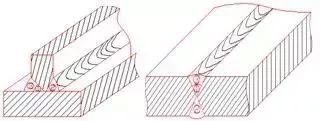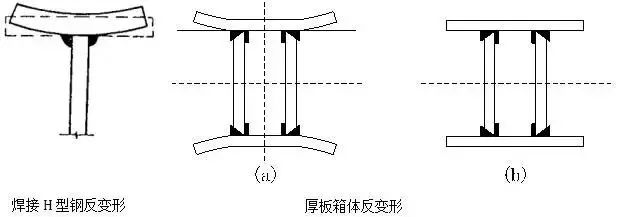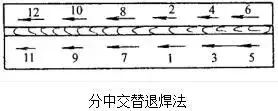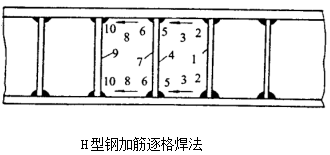1. Welding deformation control measures
(1) Conduct reasonable analysis and calculation of the structure, determine the welding deformation and shrinkage reserve, and for complex node components, the welding reserve shrinkage can be determined through testing.
(2) Control the assembly clearance
Strictly control the bevel processing accuracy and assembly clearance, and select the appropriate groove shape and welding sequence to reduce welding deformation.
(3) Use a deformation-proof tire frame
Assemble with the necessary assembly and welding tire frames, tooling fixtures, supports and reserved shrinkage margins.
(4) Make overall assembly in pieces
For complex components, as far as possible in blocks, the overall assembly welding method of production.
Block-to-piece welding:

(5) Symmetrical and uniform welding
Ø When the thick plate groove weld is welded, the number of turnovers is increased according to the deformation, and the welding is symmetrically applied, and the flame correction in the process is also matched.

Ø When the weld distribution of the component is relative to the geometrically neutral axisymmetric distribution of the component, the welding of the component adopts symmetrical uniform welding to offset the overall deformation of the component by using the principle of symmetry.
Ø The two welds arranged according to the plane neutral axis symmetry are symmetrical to each other in the same direction, the same specification, and the welding is carried out at the same time, at this time, the shrinkage or deformation of the two symmetrical welds along the vertical direction of the neutral axis of the plane will balance and cancel each other out.
Ø In order to balance the weld seam on another symmetrical plane, the weld seam on both planes is cross-welded, the welding direction is the same, the specification is the same, so that all welds must be symmetrical to the neutral axis of the component, so that the overall deformation of the component is balanced with each other and minimized.
(6) Set welding reverse deformation according to the characteristics of the joint
For the T-type welded joint with a large elongation of the wing plate, the shrinkage of the weld after welding causes the downward collapse of the outrigger part of the wing plate, and the preset welding reverse deformation before production is an effective welding method to control the welding deformation.
A. Calculate the deformation amount or angle of the elongated part of the wing plate according to the weld size (filling amount), the amount of wing plate extension, and the thickness of the wing plate;
B. Assemble the welding after the welding reverse deformation of the preset wing plate according to the calculated estimated deformation value;
C. For the thicker thickness of the wing plate, the production of a special stamping mold on the high-power press directly suppressed anti-deformation; after the normal assembly of the primer welding is completed, the flame heating method is used to preset the welding anti-deformation of the wing plate

(7) Reasonable welding order
For longer welds, under the conditions permitted by the structure, the continuous weld should be changed to an intermittent weld to reduce deformation; as when discontinuous welds are not allowed, a reasonable welding sequence should be selected to reduce or cancel each other out of welding deformation. Stepwise soldering method, fractional stepwise soldering method, jump welding method, alternating welding method, and partial symmetrical soldering method can be adopted.




2. Welding stress control and elimination measures
(1) Control of welding stress
(1) Design measures
Ø Minimize the number of welds and weld size on the structure.
Ø Symmetrical arrangement of welds to avoid excessive concentration of welds.
Ø Adopt the form of a joint with less rigidity.
(2) Process measures
a. Reduce the amount of weld fill to reduce the residual stress of welding
Ø Reasonably formulate the welding groove of the thick plate joint to reduce the amount of welding filling;
Ø Control the processing accuracy and assembly gap of the groove, and avoid increasing the amount of welding filling;
Ø Control the thick plate T joint weld seam to strengthen the welding angle, avoid increasing the welding filling amount.
b. Adopt a reasonable welding sequence to reduce the residual stress of welding
Ø When welding on the same component, the welding should be applied in the form of heat dispersion and symmetrical distribution as much as possible;
Ø When the components are welded, from the relatively fixed positions of the components to each other, to those positions that have greater relative freedom of movement between each other;
Ø Set the shrinkage margin reasonably in advance, the joint with obvious shrinkage will be welded first, and the joint with small shrinkage will be welded later, and the welding should be welded under the smallest possible constraint.

c. Ensure the preheating temperature, the maximum and minimum interlayer temperature in welding should be effectively controlled, reduce the binding degree of the welded joint, reduce the welding heat affected zone range, and reduce the welding residual stress of the thick plate welded joint;
d. Adopt reasonable welding methods, such as large melting deep melting, large current, and efficient CO2 welding methods, which can reduce the number of welding channels and reduce welding deformation and residual stress;
e. The use of compensatory heating method to reduce the stress in the weld: in the welding process, heat the other side of the welding head, the heating width is not less than 200mm, so that it and the welding area at the same time expand and contract at the same time, in order to achieve the purpose of reducing the welding stress.
f. Hammering method to reduce the residual stress of welding: after welding, a hand hammer with a small round head face is used to hammer the near seam area of the weld, so that the metal of the weld and the near seam area can be extended and deformed, which is used to compensate for or offset the compression plastic deformation generated during welding, so that the welding residual stress is reduced.
Post time: Jun-06-2022
